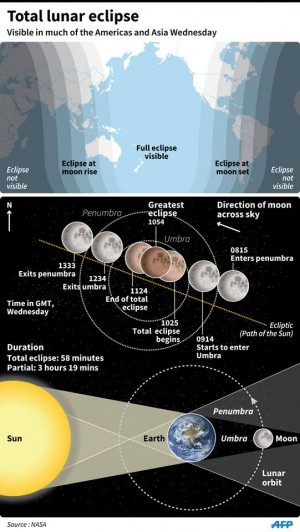
They thus missed the chance to have a clear view of the total lunar eclipse which would have been visible in the Philippines under clear skies.
Only a blurred blood moon could be seen intermittently whenever the clouds would break.
In Metro Manila, the skies eventually cleared just as the Earth’s shadow began to leave the moon’s surface.
At the observatory of the Philippine Atmospheric, Geophysical and Astronomical Services Administration (Pagasa) on the campus of the University of the Philippines in Diliman, Quezon City, astronomers and enthusiasts, who camped out to watch the eclipse, did not lose hope.
“It’s a blessing the skies cleared. Many expectators are satisfied,” said Mario Raymundo of the Pagasa observatory.
The moon is called a blood moon during a total lunar eclipse since it takes on a red coloration during the event.
Cloudy in rest of PH
During a total lunar eclipse, the Earth comes directly between the Sun and the moon, and the Earth’s shadow, called the umbra, completely covers the full moon for a time.
Only the Ilocos area in northern Luzon had clear skies on Wednesday night, the weather bureau said, to allow a sighting of the full lunar eclipse.
“It’s cloudy in the entire country. Only the Ilocos area has clear skies,” Pagasa weather forecaster Connie Badivas said minutes before the total eclipse started at 6:25 p.m.
She said the overcast skies were brought on by the intertropical convergence zone affecting the Visayas and Mindanao.
The total lunar eclipse lasted until 7:24 p.m., before the Earth’s shadow started to move away from the Moon.
The eclipse ended past 9 p.m.
The last total lunar eclipse that occurred on April 15 was partially visible in the Philippines.
The next lunar eclipse, a partial one, will occur on April 4 next year. It will be visible in the Philippines.
The next total lunar eclipse on Sept. 28 will not be visible in the country.
Earlier, Pagasa astronomer Jose Mendoza downplayed the effect of the lunar eclipse in triggering an eruption of Mayon Volcano, which authorities said was ready to erupt “in the coming weeks.”
No study on correlation
“The eclipse will only have a small contribution (to an eruption). There is no study (about the correlation). So, we cannot say for sure what will happen,” Mendoza said.
Pagasa said the lunar eclipse lasted from 4:14 p.m. Philippine standard time and ended at 9:35 p.m.
RELATED STORIES
‘Blood moon’ awes sky watchers in Americas and Asia
Blood moon not visible in most parts of PH